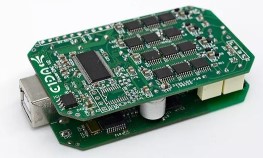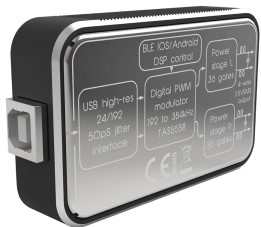A Song of Fire and IceSo I've had two DACs for a week or so that fall in the Peanuts category that pulled me into a rabbit hole and now that I've finally crawled back out I've been trying decide how to write about them. Polar opposites in design and presentation, but equally compelling and frustrating. I'm going to try and talk about them together, which is both necessary and appropriate as they are made by the same person.
The DACs are the E1DA PowerDac V2.1 and the E1DA 9038DS.
E1DA is the moniker of Ivan Khlyupin, a Russian engineer who lives in China and is a 'freelance designer in SMPS/Class D/DSP/Embedded'. His son Tyoma is a coder who helps make the apps that accompany the two dacs. Ivan is also an active member of diyaudio (IVX). So these are not farmed out of the typical Chi-fi factory stable. These are precision engineered and thoroughly documented audio products. Ivan's ethos is essentially how to leverage his proximity and knowledge re: Chinese manufacturing to make the best engineered, compact and affordable products possible while at the same creating tools to allow hobbyists to conduct technical measurements
with the same level of precision as $30K gear (via his Cosmos ADC). If you read between the lines of the bolded portion you'll understand the ramifications. So far...he's been successful. I could go on but I want to just focus on the DACs.
To learn more the E1DA website is here:
https://e1dashz.wixsite.com/indexHis Discord is here:
https://discord.com/channels/483873307251310592/616934105325764608
FireAround 2019 on diyaudio Ivan expressed his frustration with poor quality over-priced portable dacs options for his planars. His answer - design his own. But with a twist: his solution wouldn't use any off-the-shelf typical sigma-delta chips that are ubiquitous. Instead he used his background as an SMPS/ClassD engineer to make a PWM (Pulse Width Modulation) DAC! In fact, I think the *first* such DAC, certainly for the average consumer. Enter the PowerDAC (PDAC):


Tiny! The case is beautifully machined and has a high quality feel. On the back is an etching of how it works:

The PDAC comes stock w/ a 2.5mm balanced output, but an adapter is included for single ended conversion*(but see 'cons' section below). The USB doesn't need drivers for Windows or Mac/iOS. And that's it for the basic out of the box experience*. But you don't want the basic out of the box experience.
And this is where a rabbit hole opens up: You want the app, HPToy which is free to download. HPToy gives you access to the built-in DSP settings of the DAC. And hoo boy, there are a lot. So from your phone you can control not just Volume, Bass, and Treble, but Loudness, PEQ which is basically a slick equalizer, and dozens of presets based on other headphones and Harman curves and on and on. Like I said, rabbit hole:
Thing is this DAC stock sounds good (I'll get to SQ soon I promise) but IMO you *have* to use the app to bring it to life. A slight increase on the loudness setting here, adjust volume there*, bring up the PEQ at 7khz a touch... you get the picture. But it's worth it because the nature of the design is such that doing so won't detract from the sound quality as would happen with a typical DAC. There's no penalty in the PWM design (that I can discern) for tweaking to your taste, which is pretty awesome.
So how does the PDAC sound?
My expectation - and I'm sure I'm not alone given the whole 'PWM' thing - was that the PDAC would be a harsh digital aural spasm of 1s and 0s. That is not the case. In fact, the PDAC is the complete and utter opposite. IMO you will not under any circumstances mistake the PDAC for an ESS dac, or any typical Sigma Delta for that matter. I would characterize the stock PDAC as neutral/warm. The presentation overall is smooth in the mids and lower. It's hard to describe how different the PDAC is from a typical sigma-delta; smoother, perhaps. Even tube-like, perhaps due to the higher-than-usual distortion present. Yep, you read that right. PDAC won't be getting 'recommended' by the measurement site anytime soon. Strong lower midrange and bass emphasis. Upper treble and higher is subdued/further back in the mix. Powerful macrodynamics. I've never used the audiophile term 'muscular' before cause what does that even mean? Well, the cleverly designed PDAC hits the gut like Apollo Creed. If anything I find the PDAC a little too warm stock, a little too bass forward but then I again I am using HD6XXs which are already full in the midbass. I assume that combined with say planars - for which Ivan ideally designed these dacs in the first place - or other leaner sounding headphones, the presentation may be more balanced.
Soundstage is narrow and forward. In fact I would say the PDAC is like a wall of sound. Separation and depth are not a strong point - at least not single ended, maybe balanced is better. Microdetails are there, but the lower frequencies and macrodynamics dominate.
Bottom line? The PDAC is a wonderful change of pace. A little rolled off at the top, it's smooth and has slam.
Now open the app and you can refine that presentation: Up the loudness just 3-5% in the bass or lower mids and oooooohhhhhh baby, you've gone Beats. But without flabby boomy bass. Using the loudness function what you get is a refined, articulate, but hard hitting at whatever frequency you decide. Open the PEQ, slide the column wherever in the response you want and then increase or decrease the amplitude. Say 7khz, simply hold down for a sec then slide up. Now the microdetails pop, treble emphasis gets a nice boost without fatigue and it's like a whole new dac. I would avoid Treble and Bass settings as they lack the precision and just operate like, well, basic treble and bass equalizer.
Needless to say you can twiddle forever with the app in hand. Which kind of leads to the downsides of this DAC:
*Cons:
As one would expect from an engineer who hangs out at diyaudio, the PDAC is fiddly as hell and there are trade-offs that put this DAC more in the hands of an 'enthusiast' than say, a regular consumer or audiophile:
Volume. Since his dacs are designed foremost with planars in mind, these dacs put out higher than typical voltage and as such get LOUD. The PDAC's default output, even single ended, is incredibly loud. So be prepared to adjust volume more than usual. If you use the app you can set a preset that will always open at reduced volume. There is also a way to get Windows volume to default to lower volume output, but it is fiddly and best to ask Ivan or his rep on instructions. This is the kind of thing you don't have to think about with typical dacs but trust me you don't want to accidentally forget to adjust the volume with headphones on with the PDAC until you're sorted.
Line out: PDAC is headphone use ONLY. Do not try to line out to an amp. The PWM design has high DC offset single-ended that could potentially damage a preamp/amp and there is no ground for balanced to be used properly. These are non-issues for headphones, but a no-go for line out use.
App: The app is awesome but if you don't like having your phone handy (assuming the PDAC isn't directly connected to it) you're stuck with the stock performance. I don't like staring at my phone screen. Too much eye strain. That said once you've dialed in the PDAC you'll only need it for volume control. Keep in mind however
the app is mandatory to select Unbalanced outputHeat: The PDAC gets hot. REAL hot (hence FIRE). It looks cute and portable like a baby dragon. It isn't.
Compatibility: Ivan has been clear that despite its size the PDAC is meant to be more of a desktop/stationary item. It is relatively power-hungry and gets real hot so be careful about mobile usage.
Adapter: You must use the supplied adapter for single-ended use. Do not use any other adapter that has not been ok'd by E1DA.
All this is to say make sure to go the product page, read it thoroughly or read multiple reviews thoroughly.
Oh - price. ~$76 Direct from E1DA AliExpress store, $90 from retailers. Stock has been sold out lately from retailers.
Summary: I find the PDAC addictive. I've spent a bunch of money in this new round of auditioning DACs and it's tempting to sell the PDAC to at least recoup some of that. But there's something so engrossing and impressive about the sound quality, plus the looks and feel... it's almost like a collector's item to me already. This PDAC was a pleasant surprise and packs a wallop for, well, peanuts.
I'll have more to add and this probably should have been its own thread but there it is for now. Next up, the 9038DS (Ice).